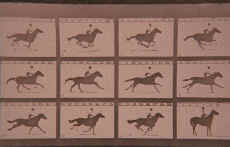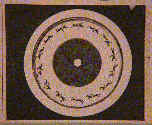|
|
|
the rocking horse or hobby-horse posture.
Pleasure riding would be restricted to the walk, perhaps the slow trot. Canter? Forget it! Driving a team of horses running like rabbits? What a wild ride that would be - it would give "having a wreck" a new meaning. Yet this was how horses at full gallop were generally portrayed.
Now look at the more contemporary painting featuring horse racing. If you've guessed that this more correctly represents the horse at full gallop you are of course correct.
|
If you've ever tried to figure out the motion (or gait) of a horse, or a dog or cat for that matter at a walk, with a little concentration you'll soon figure out the order in which the legs moved and when a hoof (or paw) leaves or touches the ground with respect to the position of the othr legs.
One artist who had a clue was the Englishman John Stubbs' whose meticulous studies of the horse's anatomy gave him an understanding as to what motion was possible and what was not.
The "Farm" in Palo Alto
Leland Stanford (1824-1893), railroad executive, governer, senator, pioneer in California's wine industry and founder of Stanford University, was also a breeder and trainer of horses. His farm (the Palo Alto Stock Farm) was one of the finest for trotting horses in the United States and in the 1880's and 1890's home to 600 horses and 150 trainers and staff.
The horse was in turn named after the first major battlefield victory of the Mexican War. Stanford's trotters won numerous trophies and ribbons and several were credited with world record times. In his quest to breed the fastest possible trotters, Stanford had a great interest in learning more details about the gait. One of the controversies at the time was whether or not a horse ever was completely airborne during the canter. The unaided human eye could not resolve that question.
Eadweard Muybridge
Enter Muybridge.
Coming to America from England at an early age, Muybridge established a reputation as one of San Francisco's great 19th century landscape photographers. Over time, his interests narrowed and became focused upon photographing and studying the motion of animals and people.
The two worked together for nearly ten years. During that time Muybridge continually improved and refined his photographic processes. By 1877, Muybridge, in collaboration with Leland Stanford's engineering staff was able to photograph movement with a shutter speed of 1/2000th of a second. It was here that he provided conclusive proof that the horse did have all four hooves off the ground during the gallop.
 What was key to the world of horse art was found in the photographs which showed every aspect of the horses' gait. The photos showed that, at full gallop, all four hooves were for an instant under the horse and off the ground.
What was key to the world of horse art was found in the photographs which showed every aspect of the horses' gait. The photos showed that, at full gallop, all four hooves were for an instant under the horse and off the ground.
If that were the case it would be amazing if the charioteer could stay aboard for even one lap!
When Muybridge's results became generally known (largely through publication in Scientific American in 1878) they were readily accepted by artists such as Degas, Eakins, George Stubbs and Remington. Others, like Rodin had to go through a period of "furious denial" before abandoning the "rocking horse" style.
His work with Stanford attracted the attention of Thomas Edison and, together with George Eastman's ongoing work in the development of film, set the stage for motion pictures. Also, as Stubb's efforts provided a new level of anatomical detail to the veterinary world, Muybridge's work introduced photography to the world of scientific data.


